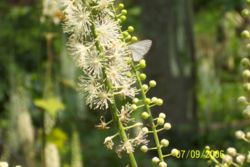Content

Medicinal Plant Working Group, Plant Conservation Alliance, US Fish & Wildlife Service
Sustainable Use and Conservation
Black cohosh is a slow-growing perennial with global demand. Because this species is primarily wild harvested and the harvest results in mortality of the plant, wild black cohosh populations may be susceptible to over-harvest. There are ongoing efforts to research harvest impacts on black cohosh and provide information to help collectors and resource managers make conservation decisions (Ford 2000; Kauffman 2002; Schlosser 2002). Wild populations must be monitored and greater emphasis must be given to cultivation.
The Medicinal Plant Working Group, Forest Service, U.S. Fish and Wildlife Service, and Garden Club of America are cooperating on a long-term monitoring study to determine regeneration rates and the impact of varying harvest levels on black cohosh (Ford 2000; Kauffman 2002; Predny et al. 2006; Schlosser 2002). The University of Massachusetts and the New York Botanical Garden are collaborating on a range-wide study of the genetic diversity of black cohosh (Predny et al. 2006).
The Conservation Committee of the Plant Conservation Alliance-Medicinal Plant Working Group began conducting inventory and monitoring projects for medicinal plants in 2000. Projects are conducted on public land and led by federal scientists and botanical experts with the assistance of lay volunteers.
“These projects exemplify the very core of the MPWG mission: To promote public/private partnerships in the sustainable use and conservation of medicinal plants. By furthering our understanding of our native flora, federal land managers can make more informed management decisions. By including our citizens in the projects, we help bring to fruition the conservation partnership model that empower citizens to take a more active role in the management of their own flora. I am very appreciative and inspired by the work we have accomplished together.” Excerpt from a letter to the Garden Club of America, Letter of Partnership, February 2006
The following good stewardship practices can help to maintain or enhance wild black cohosh populations.
- Wild-harvesters: Find out the legal requirements for wild-harvesting black cohosh in your state; rotate harvest areas; thin patches rather than collecting all available plants; leave a portion of mature and juvenile individuals untouched; replant parts of harvested roots.
- Growers: Find out the legal requirements for cultivating in your state; ensure planting stock is obtained in a way that does not threaten wild populations; consult local experts and resources for cultivation requirements in your area.
- Practitioners and Consumers: Choose sustainable-wildcrafted or verifiably cultivated sources of black cohosh bulk herbs or supplements; use black cohosh only when it is best indicated; when choosing substitutes, exercise caution not to choose a species that is equally vulnerable to over-harvest.
Lonner, J. April 2007. Medicinal Plant Fact Sheet: Cimicifuga racemosa / Black Cohosh. A collaboration of the IUCN Medicinal Plant Specialist Group, PCA-Medicinal Plant Working Group, and North American Pollinator Protection Campaign. Arlington, Virginia: PCA-Medicinal Plant Working Group.
http://www.nps.gov/plants/medicinal/plants.htm
http://www.nps.gov/plants/medicinal/projects/index.htm.


